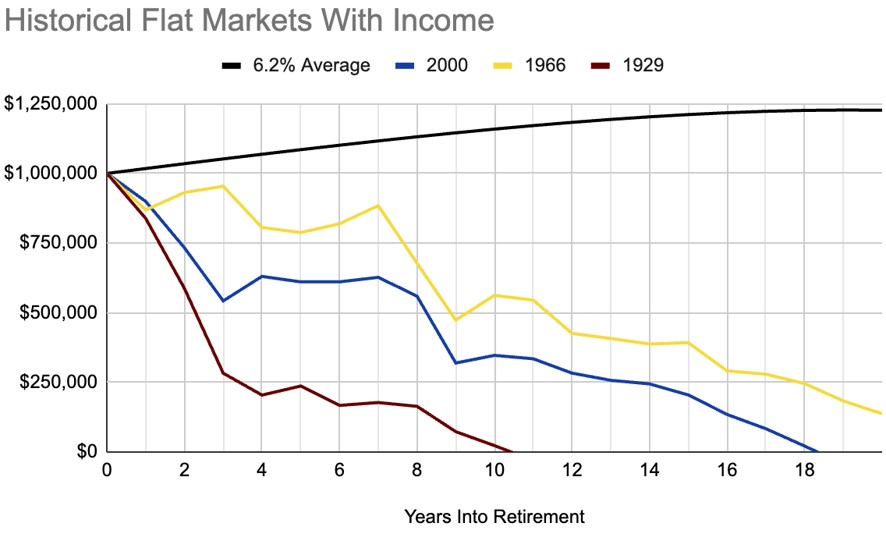Many Retirees Don’t Know About This Major Market Risk: Do You?
Flat market cycles can wreak havoc on your retirement planning. Here’s why you shouldn’t focus only on average returns.


It is common to meet someone who believes that all of their assets should be in equities, even in retirement. The rationale is that, over the long term, equities tend to be one of the best places for growth, which is true. However, these claims often point to long-term averages, which, when you dive a little deeper into the application, can be misleading.
This article is intended to address two major arguments. The first is that averages are a great tool to use when you are planning your retirement, but there’s more that needs to be addressed. The second is that the markets have a history of going flat for 10-plus years every 20 years or so, which can create some serious problems in retirement.
My intention in writing this article is to help raise your awareness of certain risks while inviting you to think outside the box and consider a more balanced and deliberate approach to your retirement income planning and portfolio management. Let’s dive in.
From just $107.88 $24.99 for Kiplinger Personal Finance
Become a smarter, better informed investor. Subscribe from just $107.88 $24.99, plus get up to 4 Special Issues

Sign up for Kiplinger’s Free Newsletters
Profit and prosper with the best of expert advice on investing, taxes, retirement, personal finance and more - straight to your e-mail.
Profit and prosper with the best of expert advice - straight to your e-mail.
Averages can be deceptive
If you had an account with $100,000 and expected that account to grow, on average, about 10%, then you would probably expect the following to happen:
- Year 0: $100,000
- Year 1: $110,000 (10% gain)
- Year 2: $121,000 (10% gain)
However, the markets are often not that consistent. For example, if you experienced a 30% loss and a 50% gain, you would still average a 10% return year over year, but you’d get a very different outcome.
- Year 0: $100,000
- Year 1: $70,000 (30% loss)
- Year 2: $105,000 (50% gain)
You may be thinking I’m rigging the math to prove a point by putting the 30% loss in year one. Let’s reverse it and see what happens.
- Year 0: $100,000
- Year 1: $150,000 (50% gain)
- Year 2: $105,000 (30% loss)
The volatility (ups and downs) matters. Taking a simple average and projecting the growth of your accounts may be problematic. This is especially true if we enter into a flat market cycle.
The flat market cycle can be rough
Historically speaking, the markets have gone flat (zero return over a period of time) for 10 years every 20 years or so. Some of the more notable flat markets over the past 100 years started in 2000, 1966 and 1929. (For more on this, see my article Four Historical Patterns in the Markets for Investors to Know).
If you put all of your assets in equities and follow the 4% rule (take 4% out of your portfolio as income each year), then you may find yourself in a difficult situation if the markets go into another flat cycle.
For context, the average return from 2000 through 2020 was about 6% to 7%. The same is true for the average return from 1966 through 1986. We will omit the 1929 average because it is significantly worse. So, assuming we take a conservative average return of 6% and draw only 4% from our portfolio, the averages would suggest that we should be fine (see the black line in the graph below).
However, if we account for the ups and downs in a flat market cycle, there’s a very different story to be told. For reference, this risk is often referred to as sequence of returns risk. See below what would have happened had you started with the same amount of assets while pulling the same amount of income but started your retirement at the beginning of one of the three historical flat market cycles.

Notice how each example has significantly less money left in the account than the “conservative 6% average” expectation. Many people could be retired for 30 years. If that is the case, and the historical flat market pattern continues, then it would be reasonable to guess that there could be a flat market cycle in your retirement. Are you prepared?
No one knows the future of the market. We could be in a flat market right now. Creating a retirement income plan based on averages when all of your assets are at risk in the equities market may not be in your best interest. How you pull income each year, especially during the first 10 years of your retirement, may matter more than your long-term average expectation.
If you feel like maybe you have too much exposure to equities, consider moving some of your assets into less risky investments or products. Many financial professionals would recommend you buy an annuity and then annuitize it into lifetime income.
I recommend using something I call a Principal Guaranteed Reservoir™, which I discuss in my book, How to Retire on Time. The idea is to have some assets in accounts that offer principal protection so that when the markets go down, you can draw income from your reservoir while you allow your other accounts to recover. This helps avoid sequence of returns risk without locking up assets for life in annuitized income.
Regardless of which way you go, remember, there’s no such thing as a perfect investment or investment strategy. It is important to put a plan together and then design your portfolio to support that plan.
Related Content
- Retirees’ Anti-Bucket List: 10 Experiences You Don’t Want
- Social Security Optimization If You Save More Than $250,000
- Five Things I Wish I’d Known Before I Retired
- The Four Headwinds of Retirement and How to Combat Them
- 1031 Exchange: Do You Know Your ‘Like-Kind’ Options?
Profit and prosper with the best of Kiplinger's advice on investing, taxes, retirement, personal finance and much more. Delivered daily. Enter your email in the box and click Sign Me Up.

Mike Decker is the author of the book How to Retire on Time, creator of the Functional Wealth Protocol, and the founder of Kedrec, a Registered Investment Advisory firm located in Kansas that specializes in comprehensive wealth planning and management at a flat fee. He specializes in creating retirement plans designed to last longer than you™, without annuitized income streams or stock/bond portfolios. In addition to helping people achieve their financial goals, Decker continues to act as a national coach to other financial advisers and frequently contributes to nationally recognized publications.
-
 I'm want to give my 3 grandkids $5K each for Christmas.
I'm want to give my 3 grandkids $5K each for Christmas.You're comfortably retired and want to give your grandkids a big Christmas check, but their parents are worried they might spend it all. We ask the pros for help.
-
 If You're Not Doing Roth Conversions, You Need to Read This
If You're Not Doing Roth Conversions, You Need to Read ThisRoth conversions and other Roth strategies can be complex, but don't dismiss these tax planning tools outright. They could really work for you and your heirs.
-
 Could Traditional Retirement Expectations Be Killing Us?
Could Traditional Retirement Expectations Be Killing Us?A retirement psychologist makes the case: A fulfilling retirement begins with a blueprint for living, rather than simply the accumulation of a large nest egg.
-
 I'm a Financial Planner: If You're Not Doing Roth Conversions, You Need to Read This
I'm a Financial Planner: If You're Not Doing Roth Conversions, You Need to Read ThisRoth conversions and other Roth strategies can be complex, but don't dismiss these tax planning tools outright. They could really work for you and your heirs.
-
 Could Traditional Retirement Expectations Be Killing Us? A Retirement Psychologist Makes the Case
Could Traditional Retirement Expectations Be Killing Us? A Retirement Psychologist Makes the CaseA retirement psychologist makes the case: A fulfilling retirement begins with a blueprint for living, rather than simply the accumulation of a large nest egg.
-
 I'm a Financial Adviser: This Is How You Can Adapt to Social Security Uncertainty
I'm a Financial Adviser: This Is How You Can Adapt to Social Security UncertaintyRather than letting the unknowns make you anxious, focus on building a flexible income strategy that can adapt to possible future Social Security changes.
-
 I'm a Financial Planner for Millionaires: Here's How to Give Your Kids Cash Gifts Without Triggering IRS Paperwork
I'm a Financial Planner for Millionaires: Here's How to Give Your Kids Cash Gifts Without Triggering IRS PaperworkMost people can gift large sums without paying tax or filing a return, especially by structuring gifts across two tax years or splitting gifts with a spouse.
-
 'Boomer Candy' Investments Might Seem Sweet, But They Can Have a Sour Aftertaste
'Boomer Candy' Investments Might Seem Sweet, But They Can Have a Sour AftertasteProducts such as index annuities, structured notes and buffered ETFs might seem appealing, but sometimes they can rob you of flexibility and trap your capital.
-
 Quick Question: Are You Planning for a 20-Year Retirement or a 30-Year Retirement?
Quick Question: Are You Planning for a 20-Year Retirement or a 30-Year Retirement?You probably should be planning for a much longer retirement than you are. To avoid running out of retirement savings, you really need to make a plan.
-
 Don't Get Caught by the Medicare Tax Torpedo: A Retirement Expert's Tips to Steer Clear
Don't Get Caught by the Medicare Tax Torpedo: A Retirement Expert's Tips to Steer ClearBetter beware, because if you go even $1 over an important income threshold, your Medicare premiums could rise exponentially due to IRMAA surcharges.
-
 I'm an Insurance Pro: Going Without Life Insurance Is Like Driving Without a Seat Belt Because You Don't Plan to Crash
I'm an Insurance Pro: Going Without Life Insurance Is Like Driving Without a Seat Belt Because You Don't Plan to CrashLife insurance is that boring-but-crucial thing you really need to get now so that your family doesn't have to launch a GoFundMe when you're gone.